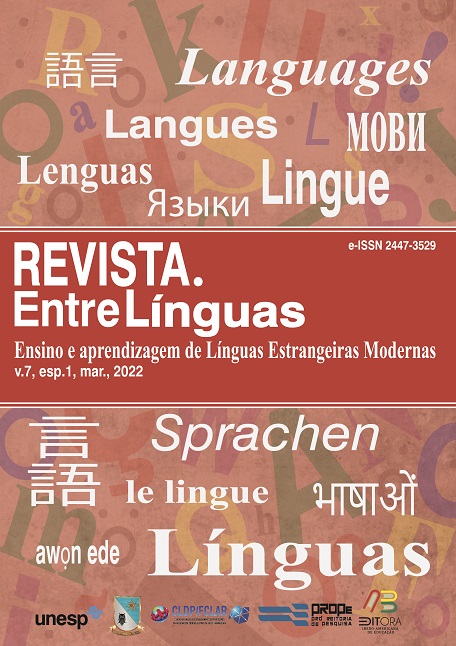El vocabulario de coronavirus como medio para reflejar el conocimiento sobre una persona
DOI:
https://doi.org/10.29051/el.v8iesp.1.16919Palabras clave:
Representación del conocimiento sobre una persona, Conceptos de oposición, Vocabulario de coronavirus ruso, Nombres de personas, Formación de palabrasResumen
El artículo examina el conocimiento sobre una persona que está representado por unidades de lenguaje creadas durante la pandemia de coronavirus. Estas unidades lingüísticas se forman utilizando métodos como la composición de palabras, la fijación, la justificación y la combinación y conforman tres categorías léxicas: "pacientes con coronavirus", "ciudadanos respetuosos de la ley que cumplen con las normas antiepidemiológicas" y "violadores de las normas antiepidemiológicas". Se describen las características de los conceptos representados por las unidades lingüísticas de estas tres categorías, se muestra que los conceptos transmitidos por las unidades lingüísticas de las categorías "ciudadanos respetuosos de la ley que observan las normas antiepidemiológicas" y "violadores de las normas antiepidemiológicas". reglas" puede considerarse como oposicional. Se presta especial atención al análisis de los componentes utilizados en la composición de palabras y afijos, con la ayuda de los cuales se crean unidades derivadas.
Descargas
Citas
AKUT, K. B. Morphological Analysis of the Neologisms during the COVID-19 Pandemic. International Journal of English Language Studies, v. 2, n. 3, p. 1-7, 2020. Available in: https://al-kindipublisher.com/index.php/ijels/article/view/90. Access in: 26 Jan. 2021.
ASIF, M. et al. Linguistic analysis of neologism related to coronavirus (COVID-19). Social Sciences & Humanities Open, v. 4, n. 1, 100201, 2021. Available in: https://www.sciencedirect.com/science/article/pii/S2590291121000978?via%3Dihub. Access in: 20 Jan. 2021.
BURRIDGE, K.; MANNS, H. ‘Iso’, ‘boomer remover’ and ‘quarantini’: How coronavirus is changing our language. The Conversation, 2020. Available in: https://theconversation.com/iso-boomer-remover-and-quarantini-how-coronavirus-is-changing-our-language-136729. Access in: 07 Feb. 2021.
BUTSEVA, T. N.; ZELENIN, A. V. Lexicography in the situation of neological extreme (based on the material of neolexics associated with the coronavirus pandemic). Bulletin of Cherepovets State University, v. 6, n. 99, p. 86-105, 2020. Available in: https://www.elibrary.ru/item.asp?id=44387469. Access in: 27 Jan. 2021.
CATERMINA, V. V.; LIPIRIDI, S. H. Features of displaying the coronavirus pandemic in the vocabulary of medical discourse (based on English neologisms). Izvestiya Volgograd State Pedagogical University, v. 4, n. 147, p. 170-175, 2020. Available in: https://www.elibrary.ru/item.asp?id=42882761. Access in: 10 Feb. 2021.
DICTIONARY OF THE RUSSIAN LANGUAGE OF THE CORONAVIRUS ERA. Saint Petersburg: Institute of Linguistic Research of the Russian Academy of Sciences, 2021.
GEKKINA, E. N. Covid versus coronavirus: from observations of regular cases of derivational differences. In: SERGEEVNA, G. E.; SERGEEVNA, P. A.; NIKOLAEVNA, P. M. (eds.). New words and dictionaries of new words. Saint Petersburg: OR RAS, 2020.
GRISHKINA, E. N. The problem of correlation between the concepts of "neologism" and "new word" (psycholinguistic aspect). Yekaterinburg: Ural Federal University, 2016.
KHALFAN, M.; BATOOL, H.; SHEHZAD, W. Covid-19 Neologisms and their Social Use: An Analysis from the Perspective of Linguistic Relativism. Linguistics and Literature Review, v. 6, n. 2, p. 117-129, 2020. Available in: https://papers.ssrn.com/sol3/papers.cfm?abstract_id=3819563. Access in: 22 Jan. 2021.
MAP OF WORDS AND EXPRESSIONS OF THE RUSSIAN LANGUAGE. Kartaslov, n.d. Available in: https://kartaslov.ru. Acesso em: 11 Feb. 2021.
MINEEVA, Z. I. Neoderivaty in the Russian language of the pandemic era, In: New words and dictionaries of new words. In: SERGEEVNA, G. E.; SERGEEVNA, P. A.; NIKOLAEVNA, P. M. (eds.). New words and dictionaries of new words. Saint Petersburg: OR RAS, 2020.
MITURSKA-BOJANOVSKA, Y. Word-formation contamination in the era of coronavirus (based on colloquial speech and newspaper headlines). In: SERGEEVNA, G. E.; SERGEEVNA, P. A.; NIKOLAEVNA, P. M. (eds.). New words and dictionaries of new words. Saint Petersburg: OR RAS, 2020.
MOSKALEVA, M. V. Neologisms and the problem of their study in modern Russian. Proceedings of Herzen Russian State Pedagogical University, v. 80, p. 246–250, 2008. Available in: https://cyberleninka.ru/article/n/neologizmy-i-problema-ih-izucheniya-v-sovremennom-russkom-yazyke. Access in: 9 Jan. 2021.
PAVLOVA, A. S. The names of the COVID-19 coronavirus infection in Russian, English and German: cultural and national specifics. In: SERGEEVNA, G. E.; SERGEEVNA, P. A.; NIKOLAEVNA, P. M. (eds.). New words and dictionaries of new words. Saint Petersburg: OR RAS, 2020.
SAVCHENKO, A.V.; YAN-JUN, L. “Coronavirus neologisms”: From vocabulary and phraseology to Internet memes (based on the material of Russian and Chinese). Communicative research, v. 7, n. 4, p. 865-886, 2020. Available in: http://com-studies.org/images/magazine/2020/KI_4_2020.pdf. Access in: 19 Feb. 2021.
ZELENIN, A. V.; BUTSEVA, T. N. From sididomites to coronapophigists (Names of persons during the coronavirus pandemic). Russian language at school, v. 81, n. 6, p. 97-106, 2020. Available in: https://www.riash.ru/jour/article/view/1433. Access in: 24 Jan. 2021.
Publicado
Cómo citar
Número
Sección
Licencia

Esta obra está bajo una licencia internacional Creative Commons Atribución-NoComercial-CompartirIgual 4.0.
Os manuscritos aceitos e publicados são de propriedade da Revista EntreLínguas. Os artigos publicados e as referências citadas na Revista EntreLínguas são de inteira responsabilidade de seus autores.
Transferência de direitos autorais – autorização para publicação
Caso o artigo submetido seja aprovado para publicação, já fica acordado que o(s) autor(es) autoriza(m) a UNESP a reproduzi-lo e publicá-lo na EntreLínguas, entendendo-se os termos “reprodução” e “publicação” conforme definição respectivamente dos incisos VI e I do artigo 5° da Lei 9610/98. O artigo poderá ser acessado pela rede mundial de computadores (Internet), sendo permitidas, a título gratuito, a consulta e a reprodução de exemplar do artigo para uso próprio de quem a consulta, desde que haja a citação ao texto consultado. Essa autorização de publicação 328 EntreLínguas, Araraquara, v. 1, n .2, p. 323-328, jul./dez. 2015 não tem limitação de tempo, ficando a UNESP responsável pela manutenção da identificação do(s) autor(es) do artigo. Os artigos publicados e as referências citadas na Revista EntreLínguas são de inteira responsabilidade de seus autores.











